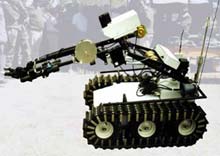Robot device dusts potential bombs for finger prints

Bomb disposal robot with RAFFE attachment <br>Image: Kristian Dixon
Police who need to dust suspicious packages for fingerprints could someday rely on a robotic device to do this dangerous work.
The device, developed by scientists from U of T and the University of Calgary, offers a safe way to collect fingerprint evidence from packages that might be too dangerous for a human to approach. A study describing the development of the device, called a Robot Accessory for Fuming Fingerprint Evidence (RAFFE), appears in the March 2004 issue of the Journal of Forensic Sciences. “With the recent terrorist threats, police would want to collect as much evidence as possible,” says lead author Kristian Dixon, a third-year U of T engineering science student. “But if a bomb were to go off while an officer was manually dusting the package, he could either lose his hands or his life.”
Currently, police robots simply destroy suspicious packages – along with any fingerprint evidence. RAFFE consists of a small box with a heating element, cartridge of Superglue and short pipe. Using remote controls, police direct the robot to the package and heat the Superglue in the box. The glue produces fumes that are piped towards the package. The fumes, containing cyanoacrylate, react with the oils and moisture in the fingerprints, turning them white. The fingerprints can then be photographed using the robot’s high-definition camera prior to the safe disposal of the package. The study was funded by the Natural Sciences and Engineering
CONTACT:
Kristian Dixon, Division of Engineering Science, Faculty of Applied Science and Engineering, ph: (519) 884-5142 x364 or (519) 573-5152; e-mail: kristian.dixon@utoronto.ca
U of T Public Affairs, ph: (416) 978-6974; e-mail: nicolle.wahl@utoronto.ca
Media Contact
More Information:
http://www.newsandevents.utoronto.ca/bin5/040419a.aspAll latest news from the category: Process Engineering
This special field revolves around processes for modifying material properties (milling, cooling), composition (filtration, distillation) and type (oxidation, hydration).
Valuable information is available on a broad range of technologies including material separation, laser processes, measuring techniques and robot engineering in addition to testing methods and coating and materials analysis processes.
Newest articles

Parallel Paths: Understanding Malaria Resistance in Chimpanzees and Humans
The closest relatives of humans adapt genetically to habitats and infections Survival of the Fittest: Genetic Adaptations Uncovered in Chimpanzees Görlitz, 10.01.2025. Chimpanzees have genetic adaptations that help them survive…

You are What You Eat—Stanford Study Links Fiber to Anti-Cancer Gene Modulation
The Fiber Gap: A Growing Concern in American Diets Fiber is well known to be an important part of a healthy diet, yet less than 10% of Americans eat the minimum recommended…

Trust Your Gut—RNA-Protein Discovery for Better Immunity
HIRI researchers uncover control mechanisms of polysaccharide utilization in Bacteroides thetaiotaomicron. Researchers at the Helmholtz Institute for RNA-based Infection Research (HIRI) and the Julius-Maximilians-Universität (JMU) in Würzburg have identified a…



